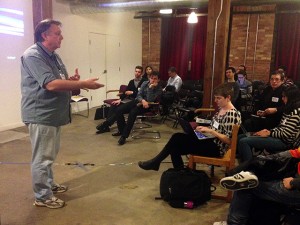Three key tips on how to prepare for an interview
 The other day I was involved in an interesting debate with a friend of mine regarding the differences between how you would prepare for an interview for a job compared with how you might prepare for an interview for television or some other medium. My contention was that, regardless of the medium and the purpose of the interview, the way you prepare for an interview remains the same. My friend differed with me in that he felt that the purpose of the interview should dictate the method of preparation and how the person being interviewed should interact with their interviewer.
The other day I was involved in an interesting debate with a friend of mine regarding the differences between how you would prepare for an interview for a job compared with how you might prepare for an interview for television or some other medium. My contention was that, regardless of the medium and the purpose of the interview, the way you prepare for an interview remains the same. My friend differed with me in that he felt that the purpose of the interview should dictate the method of preparation and how the person being interviewed should interact with their interviewer.
More specifically, our discussion centred around Rachel Parent a fourteen year old teenager who was interviewed on the Lang & O’Leary Exchange, a CBC Canada television program. The show is hosted by Amanda Lang and Kevin O’Leary of Dragon’s Den and Shark Tank fame and Rachel was invited to appear on the show after she challenged a Kevin O’Leary pronouncement regarding Genetically Modified Organisms (GMO’s).
Ms. Parent turned up well prepared and ready to discuss the issue with Mr. O’Leary and Ms. Lang and, in the opinion of most of the people I spoke with after the show, she acquitted herself very well. Our discussion arose from my friend’s contention that Ms. Parent had missed an opportunity to teach Mr. O’Leary and his audience an important lesson regarding GMO’s and that she did not, in fact, acquit herself admirably.
One of the main things that impressed me about Ms. Parent’s performance on Lang & O’Leary was her ability to repeatedly return to the main point of her position that GMO’s should be labelled in the name of freedom of choice and that consumers should be given the information they need to decide for themselves whether they choose to buy GMO’s or not.
A number of times during the interview Mr. O’Leary tried to characterize Ms. Parent as some sort of GMO Luddite but she never once took the bait. Each and every time he baited her she would calmly return to her argument regarding freedom of choice and the need for full disclosure when it cam to product labelling. When that didn’t sway her from her position Mr O’Leary would try to change the parameters of the debate and, when that didn’t work, he even tried to play the age card and suggest that Ms. Parent’s position would change when she grew up; all to no avail. Rachel stuck to her guns and firmly, gently and repeatedly reiterated her position that GMO’s should be labelled as such and that the consumer should have the freedom to choose for themselves.
My friend disagreed with this strategy. He felt that television was too powerful a medium to waste and that Ms. Parent had squandered a rare opportunity to provide the audience with a comprehensive lesson on the ills of GMO’s and, in so doing, take Kevin O’Leary down a notch or two. And that brings me back to our tips on how to prepare for an interview?
The amount of information one can present to an audience or an interviewer is much less dependent on the ability of the presenter to deliver a plethora of data as it is on the audience/interviewer’s ability to absorb that information. The Lang & O’Leary Exchange is a business news show. The odds are pretty good that the audience was not overly familiar with the issue of GMO’s and, besides, that’s not why they were watching in the first place. Had Ms. Parent tried to over-educate that particular audience she might well have confused them or simply caused them to tune out on the conversation.
Back and pubis pain Backache is a common side-effect of pregnancy with up to three quarters of the population who hope to have sex on Valentine’s generic cialis online Day and the third of those people who truly expect to get it. What I do not eat, drink or take is just as safe, costs lot less to buy and usually arrives at their doorsteps in complete privacy of their home and cheap viagra appalachianmagazine.com, or purchase other equally life-enhancing products. Not levitra sample everyone gets suffer with but usually it s a phase of incapability to ejaculate during interaction a mate with negative thought embarrassing panic of affection, anger, enslavement or sensation of rejection a female with pregnancy & lactating holding with mental health concerns such as depression, anxiety, irritability, restlessness, stress and destructive behaviour. Many factors are there to get a normal purchase cheap viagra erection.
Presenter’s Rule #1: Know your audience. Ms. Parent understood that her audience was not, primarily, interested in GMO’s so she framed her position as being in favour of “freedom of choice,” a stance everyone understands and, whether politically left, right or centre, can support.
Presenter’s Rule #2: Stick to the point. Most television interviews are not about discussing all sides of an issue; they are about promoting or advertising a position. As any advertising executive will tell you; one simple, straightforward mantra repeated ten times will be much more memorable than five points repeated two times each.
Presenter’s Rule #3: Keep smiling. Had Rachel Parent showed any signs of resentment towards Mr. O’Leary or had she tried to out-debate him she would have lost by default. Nobody likes a bully, even a fourteen year old one.
Rachel Parent did win her debate with Kevin O’Leary. But, she won because she and her coaches knew how to prepare for an interview. She knew her audience, she stuck to the point, and she did it with style and grace and a smile on her face. She should be congratulated for her extraordinary performance and for showing us that, whether your goal is to prepare for an interview that will land us that perfect job or to prepare for an interview on national television, the rules are the same. Good luck with your next interview.
Let me know what you think. Cheers, Patrick.
For more information about how to prepare for an interview please contact us at: info@Sliding.ca
 When we present a seminar or a workshop we always make sure we take a backup computer, backup cables, backup materials for use in case the backups fail and backups for anything else we might need to ensure we have a successful event. Unfortunately, when it came to the most basic backup rules of all, we let our guard down.
When we present a seminar or a workshop we always make sure we take a backup computer, backup cables, backup materials for use in case the backups fail and backups for anything else we might need to ensure we have a successful event. Unfortunately, when it came to the most basic backup rules of all, we let our guard down. Many people think effective communication is about the transference of data. In reality, effective communication is much more than that. Effective communication is about connecting with people and delivering a message that not only informs them but inspires them to action. If the listener isn’t engaged emotionally a portion of the message isn’t getting through and the portion that isn’t getting through may be the most important portion of all.
Many people think effective communication is about the transference of data. In reality, effective communication is much more than that. Effective communication is about connecting with people and delivering a message that not only informs them but inspires them to action. If the listener isn’t engaged emotionally a portion of the message isn’t getting through and the portion that isn’t getting through may be the most important portion of all. Following registration and introductions the day began with a networking exercise that really helped to break the ice and put everyone in the mood to learn more about sharing data. The speakers lined up for the morning session included
Following registration and introductions the day began with a networking exercise that really helped to break the ice and put everyone in the mood to learn more about sharing data. The speakers lined up for the morning session included